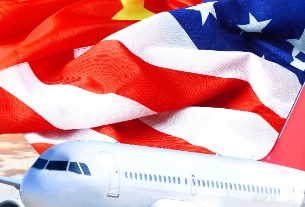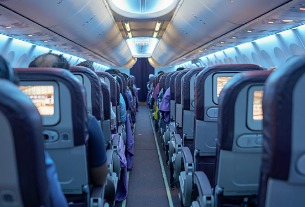Fare fights can quickly escalate in big airports like Chicago’s O’Hare, a hub for American and United.
After shrugging off their lowest-cost rivals, the biggest U.S. airlines are now taking them head on—resulting in a bonanza of cheaper tickets that is benefiting fliers but weighing on revenue.
Plummeting fuel costs have helped make it more profitable to add flights and seats, extending already rapid expansions by ultralow-cost carriers Spirit Airlines Inc. and Frontier Airlines. Those two offer cut-rate fares while charging fees for basic things like printed boarding passes and seat assignments.
Spirit has doubled its seats in Chicago since 2012, for example, and added 27% in Dallas. Meanwhile, established discount giant Southwest Airlines Co. has ballooned its capacity in Dallas, one of its largest airports and where it was freed from federal restrictions late last year.
The trends have pressured the three largest carriers by traffic: American Airlines Group Inc., United Continental Holdings Inc. and Delta Air Lines Inc.
In years past, they generally avoided broad fare skirmishes with their upstart competitors. Now, also emboldened by cheap fuel, they are responding aggressively.
American in late December was selling a round-trip flight from Dallas/Fort Worth International Airport to Fort Lauderdale, Fla., on Jan. 5, returning Jan. 14, for as little as $131.20. Spirit’s cheapest fare was $116.18.
On the same dates, a round trip from Chicago’s O’Hare International to New York’s La Guardia Airport was $87.19 on Spirit, $116.20 on United, $136.20 on American and $206.20 on Delta.
Bob Harrell of Harrell Associates LLC, which tracks about 300 big domestic routes from the three largest airlines, estimates the lowest leisure fares in late December were down 24% on average from a year ago, with prices from Chicago down 54%, Philadelphia down 48%, and Dallas down 40%.
Overall declines for much of 2015 were smaller, but still significant. A December study of most North American airlines found that North American economy-class ticket prices fell 5% through the first 10 months of 2015 over the year-ago period.
The study was done by online ticket seller Expedia Inc. and Airlines Reporting Corp., a clearinghouse that settles most airlines’ ticket transactions with travel agents. Southwest, not included in the study, said its average one-way fare declined 4% in the third-quarter from a year earlier.
The changes come as the big carriers were criticized for much of the year by politicians and consumer groups who said they were using combined market power created by industry consolidation to keep fares high.
But executives say market dynamics, not criticism, are causing them to adjust, as they feel increasingly compelled to take the super discounters’ growing popularity more seriously.
Scott Kirby, president of American, said its response to discounters now is “more comprehensive” than its prior “hit or miss” approach. He said 87% of American’s customers, accounting for half its revenue, fly once a year or less and are largely price-sensitive, a group that is too big to ignore.
“We are being price competitive really across the board,” Mr. Kirby said in a recent interview. “And that has been an evolution.”
The full-service airlines “have been competing on the high-end business travelers,” said Jonathan Kletzel, a transportation consultant for PricewaterhouseCoopers LLP. They have “ignored” infrequent, price-conscious, leisure travelers and now “they have realized they need to stem the bleeding” to lower-fare rivals.
Fare fights can quickly escalate in big airports like Chicago’s O’Hare, a hub for American and United. Jim Compton, United’s chief revenue officer, said recently that his airline was pressured after American at O’Hare started trying to match pricing from Southwest, which flies out of Chicago’s Midway Airport. “Once a large competitor does that, it’s a lot of inventory at O’Hare that’s exposed competitively,” he said.
In Dallas, Southwest boosted its number of seats out of Love Field by 46% this year alone from 2014, after a law that limited its destinations from that airport was repealed in late 2014. Andrew Watterson, a Southwest senior vice president, said the airline “certainly aspires to recapture” the position of being the lowest-cost carrier, but currently is being undercut by some of the ultra discounters.
Delta, taking a surgical approach, three years ago started offering “Basic Economy” fares on a few routes that overlapped with discounters as a defensive move, said Glen Hauenstein, chief revenue officer. Now these fares are available on about 450 routes, he said, offering modestly lower prices but allowing no itinerary changes or advance seat assignments.
For a round trip from Atlanta to Fort Lauderdale on Jan. 5, returning Jan. 14, Delta recently offered a Basic Economy fare of $116, versus Spirit’s $74.
‘We are being price competitive really across the board. And that has been an evolution.’—Scott Kirby, president of American
Mr. Hauenstein said, though, that Delta has found that some 50% or more of customers who look at that fare option instead purchase a higher-priced ticket with more perks.
American and United recently have said they plan similar no-frills fares. Brett Hart, United’s acting chief executive, said its program is intended to be “an elegant way to appeal to our whole base,” including customers who could fly with Spirit or Frontier. “We service a broad array of customers who are interested in different things when they travel,” he said in an interview. United has “to be realistic.”
While lowering fares, airlines also have added seats to existing planes to lower costs. That has reduced a key metric called unit revenue—the amount airlines take in for each passenger flown a mile—raising concern among investors even as airlines have been reporting record profits. American expects its fourth-quarter unit revenue to be off by 5% to 7% from a year ago, after falling 6.8% in the third quarter.
The discounters also are taking hits. Spirit’s average one-way ticket revenue in the third quarter was down nearly 21% from the year before—though revenue from fees was roughly flat. Spirit’s stock price, riding high at $82 in February, started sliding in April and hit a low of $33 in mid-November. It has recovered to $42.46, up 0.6%, in 4 p.m. trading Tuesday.
Spirit CEO Ben Baldanza said in an interview that the big carriers have long tried to insulate themselves from discounters’ fares. But this year “American has taken a more aggressive tack against Spirit, Frontier and Southwest, clearly,” he said.
David Cush, CEO of moderately low-fare Virgin America Inc., said he saw “tremendous discounting” from the big three carriers in November. He said that Virgin America had “largely ignored Spirit and Frontier pricing until American started matching.” The fare strategy of the Big Three “is very expensive,” he said.




